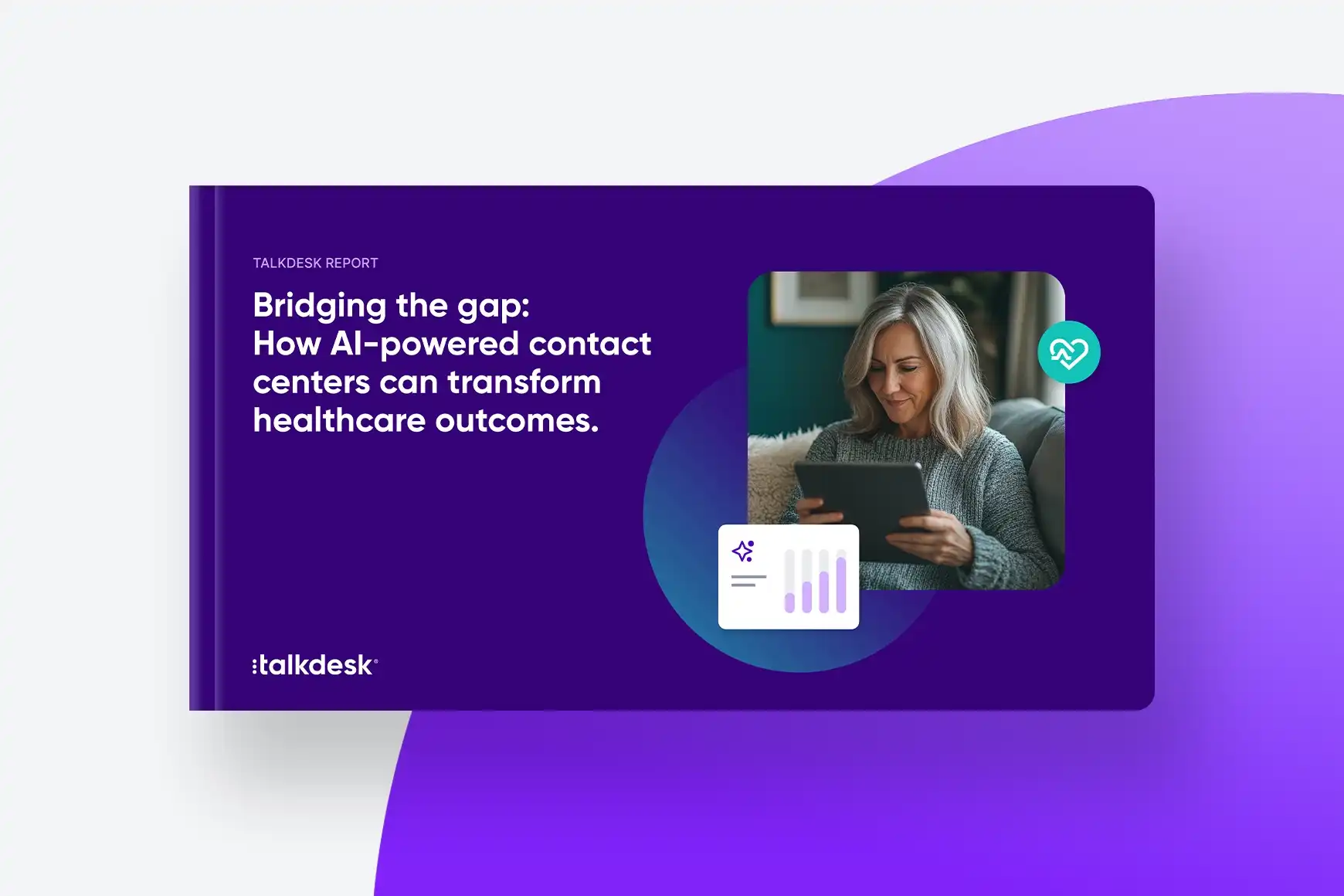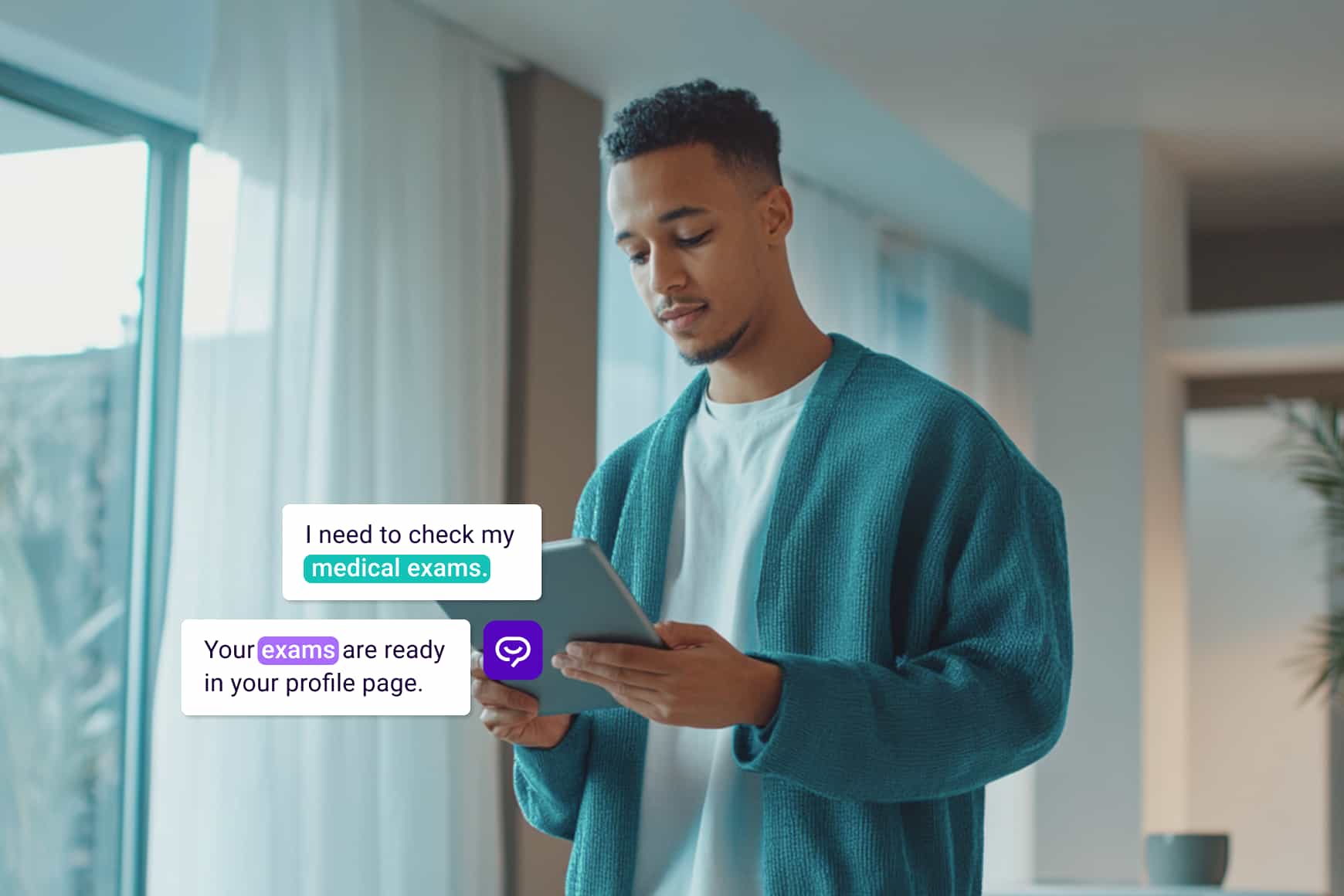How AI is reshaping healthcare’s front door

By Patty Hayward
0 min read

For years, healthcare contact centers have operated as unsung workhorses in the patient journey, handling everything from appointment scheduling to prescription refills. But as expectations rise and AI transformation accelerates, the role of the contact center is shifting from a cost center to a catalyst for better care and new operational efficiency for health systems.
At Talkdesk, we wanted to understand how organizations are navigating this shift. In collaboration with CHIME, we surveyed 77 technology leaders from major U.S. hospitals to explore this transformation. The result is our latest report: Bridging the gap: How AI-powered contact centers can transform healthcare outcomes. We learned that while many are still struggling with disconnected systems and outdated processes, some are already using AI to proactively engage patients, reduce wait times, and free up clinical staff to focus on what really matters, which is delivering care.
What we found was both a clear vision for transformation and a gap between ambition and execution. The insights offer a clear picture of the industry’s current state and a strategic direction to meet the expectations of modern healthcare.
Talkdesk Report

Report
Bridging the gap: How AI-powered contact centers can transform healthcare outcomes
Healthcare contact centers are key to quality care, yet many struggle with outdated systems. How are leading organizations modernizing, and what can others do to catch up?
From operational necessity to strategic asset.
Traditionally, healthcare contact centers have been measured by metrics like call abandonment rates and average handling times. However, the report highlights a striking disconnect: while 97% of hospital leaders prioritize fast and convenient patient service, only 21% align their contact center KPIs with value-based care outcomes.
This misalignment highlights a missed opportunity. Leaders acknowledge the importance of patient outcomes, yet many lack the KPIs, measurement tools, and improvement plans to drive progress. By realigning contact center metrics with strategic goals and improvement plans, organizations can transform these centers into drivers of patient adherence, reduced readmissions, and enhanced satisfaction.
Demystifying AI integration in healthcare contact centers.
Most healthcare executives have been tasked with implementing AI or determining its strategic value. But, for many, AI remains an abstract concept—a powerful idea without clear execution. What exactly does implementing AI in a healthcare contact center entail, and how can it benefit an organization?
History shows that skepticism toward new technology is nothing new in healthcare. For example, when the HITECH Act promoted widespread adoption of Electronic Health Records (EHRs) around 2009, many physicians voiced strong doubts, arguing, “Paper is faster—EHRs will just slow us down.” Yet today, EHRs are the backbone of modern healthcare, enabling seamless data sharing, population health management, and the integration of predictive AI tools into daily operations.
Healthcare leaders see the need. Currently, nearly 60% of hospitals plan to adopt AI solutions within the next two to four years, although only 5% feel they’re equipped to implement AI and understand how to fully maximize its benefits. This gap mainly occurs because many AI solutions available today aren’t specifically designed for healthcare. Often, these solutions fail to integrate smoothly with EHR systems, causing fragmented processes, operational inefficiencies, and heightened concerns around HIPAA compliance and data security, echoing the same integration challenges providers initially faced with EHR implementation.
Even today, only 12% of hospitals have fully integrated their contact center systems with their EHR platforms. The same hesitation and technical barriers that initially slowed EHR adoption continue to persist, but now in the communications tech stack. In fact, 43% of contact center agents still manually toggle between separate systems, echoing the inefficiencies healthcare providers grappled with in the early days of EHRs. This ongoing fragmentation reduces productivity, extends patient wait times, and weakens overall patient trust and satisfaction.
However, when healthcare-specific AI solutions are implemented correctly, the outcomes are transformative:
-
Improved patient engagement. 74% of respondents stated appointment management was the most frequent reason for patients engaging with their contact center. AI can proactively identify at-risk patients based on data patterns, significantly reducing no-shows and missed appointments, issues linked to billions in lost healthcare revenue annually.
-
Enhanced operational efficiency. Automating routine tasks like scheduling, prescription refills, and billing inquiries can free staff to focus on complex, emotionally nuanced interactions, reducing operational costs by up to 25%.
-
Better clinical outcomes. Integrated AI solutions enable seamless multichannel communication, providing real-time, accurate information across the care continuum. And 88% of healthcare organizations recognize population health outcomes as critical contact center KPIs, reflecting AI’s potential to significantly influence patient adherence, reduce readmissions, and improve overall health outcomes.
This capability isn’t merely theoretical, it’s actively reshaping patient care today, creating experiences that are both efficient and deeply patient-centered.
Redesigning patient care with AI.
Healthcare executives must reframe their view of contact centers from costly operational units to a critical department for driving value-based care. Instead of asking, “How can we improve basic CX?” leaders should consider, “How can we leverage contact centers as strategic assets that elevate the patient journey?” Here’s how:
-
Proactive care vs. reactive response. AI-driven platforms analyze patient data in real time to identify patients needing attention, such as chronic illness patients overdue for a medication refill or checkup. These platforms trigger automatic outreach and reminders, reducing preventable hospital admissions and boosting adherence to care plans.
-
Unified patient experiences. Seamless integration between contact centers and Electronic Health Records (EHRs) means contact center agents can instantly retrieve patient history, recent appointments, or medication changes, ensuring personalized and timely responses. For example, when a patient calls to handle a seasonal flu vaccine appointment, the system can see they may also have an open specialist referral and proactively recommend scheduling that visit as well.
-
Empathetic automation. Healthcare-specific AI agents go beyond scripted answers, intuitively managing sensitive interactions. If a patient expresses anxiety or hesitation during an automated scheduling call, AI recognizes emotional nuances and can adapt in real time or escalate to a live agent, preserving patient comfort, privacy, and trust.
Real-world successes in AI transformation.
Healthcare organizations leveraging AI solutions are already seeing remarkable results:
- Memorial Healthcare System integrated EHR with its contact center, achieving a 30% increase in service level.
- Evara Health automated nearly half of their patient calls, cutting wait times by an impressive 120%.
- Integra Managed Care now efficiently supports over 45,000 patients with AI-enhanced operational capabilities.
These organizations provide concrete evidence that strategic AI investment in contact centers delivers measurable improvements in patient outcomes and operational efficiency.
Strategic questions for healthcare leaders.
For healthcare executives considering AI-driven contact center transformations, critical strategic questions emerge:
-
Are your contact center metrics aligned with strategic goals such as value-based care outcomes?
If not, why not? If they are aligned, do you have a robust plan in place to consistently track, evaluate, and improve these KPIs?
-
Have you fully integrated your contact center systems with your EHRs?
If not, what barriers—technological, regulatory, or operational—have prevented this integration?
-
Are you leveraging AI capabilities to proactively engage and support patients? How specifically are you using these technologies to reduce readmissions, increase patient adherence, and improve clinical outcomes?
Addressing these strategic questions not only clarifies the vision but directly positions the healthcare organization for measurable improvements in care quality, patient satisfaction, operational efficiency, and financial performance.
Elevating patient experiences through intentional design.
Patients perceive healthcare as a seamless experience, not organizational silos. Many significant moments—whether during uncertainty, urgent concerns, or important decisions—occur within contact centers.
By strategically investing in AI-driven contact center solutions designed specifically for healthcare, leaders can significantly enhance the quality and responsiveness of patient interactions. This intentional shift—moving from viewing contact centers as mere operational requirements to essential tools in delivering proactive and patient-centered care—allows healthcare organizations to provide better, more personalized experiences at every critical touchpoint.





